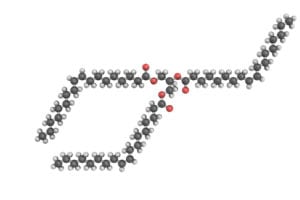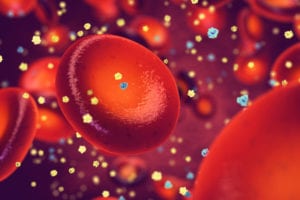
Keto and Body Composition: What Our Study Showed
Critiquing a study based on the abstract is like reading the back of a book and trying to tell someone the details of what happens. There’s much more…

Unlike the other macronutrients, fat can account for anywhere between 5-80% of your total body mass. It has an unlimited potential to be stored on your body. Anatomically, this fat is stored either as subcutaneous or visceral fat. Subcutaneous fat sits right underneath your skin, but on top of muscle tissue. Visceral fat surrounds organs within your body.
Fat, as a whole, is actually considered an organ within your body. Adipose tissue, or fat, is actually considered an endocrine organ because it can secrete hormones. Some key hormones secreted by adipose tissue include estrogen, leptin (the satiety hormone), and adiponectin (anti-inflammatory). Additionally, inflammatory immune cells like interleukins (like iL-6) and TNF-alpha (tumor necrosis factor) are also secreted by adipose tissue.
 Fat is stored within the body as triglycerides. Triglycerides are made up of three fatty acids (“tri”) and a glycerol molecule (“glyceride”). When using fat for energy, these triglycerides are broken down into their original components. Fatty acids are released into the blood, which can be used for energy. This process is known as lipolysis (lipo = fat, lysis = breakdown).
Fat is stored within the body as triglycerides. Triglycerides are made up of three fatty acids (“tri”) and a glycerol molecule (“glyceride”). When using fat for energy, these triglycerides are broken down into their original components. Fatty acids are released into the blood, which can be used for energy. This process is known as lipolysis (lipo = fat, lysis = breakdown).
Fat cells can continue to grow through a process known as hypertrophy (hyper= increase, trophy = size). When new fat cells are formed, this is known as hyperplasia (hyper= increase, plasia= cellular multiplication). Adults only experience an increase or decrease in fat cell size, but no changes to the total number of fat cells. When you lose weight, you are losing fat cell size, not the total number of fat cells do not change unless you are morbidly obese. Research suggests the total number of fat cells is determined during childhood and the more fat cells you have, the easier it will be to gain fat. This is why it is so important for children to eat a healthy diet.
Insulin inhibits the breakdown of fat or lipolysis, which is why insulin is often known as the fat-storage hormone. Insulin also plays a key role in nutrient partitioning, which the process of determining where nutrients go when you consume them (like whether energy goes to your muscle or to fat). Both fat and muscle tissue contain enzymes that breakdown fat, activation of these enzymes in muscle tissue will help remove fat from the blood and break them down. However, lipoprotein lipase activation within fat tissue will pull fat from the blood and store it within fat tissue. To recap, the goal is to activate the fat breakdown enzymes in muscle and suppress these enzymes in fat.
 Mitochondrial health also plays a key role in fat loss. If fat has been pulled into the muscle, it must then be transported into the mitochondria to be burned. The higher the amount of CPT1s (carnitine palmitoyltransferase I), the transporter protein that transports fat into the mitochondria, the more fat that can be pulled into the mitochondria and burned. Insulin reduces or prevents the transport of fat into the mitochondria. This can be overcome through exercise or following a low-carbohydrate diet that can reduce insulin and activate AMPK (5′ AMP-activated protein kinase) to allow transport to still occur.
Mitochondrial health also plays a key role in fat loss. If fat has been pulled into the muscle, it must then be transported into the mitochondria to be burned. The higher the amount of CPT1s (carnitine palmitoyltransferase I), the transporter protein that transports fat into the mitochondria, the more fat that can be pulled into the mitochondria and burned. Insulin reduces or prevents the transport of fat into the mitochondria. This can be overcome through exercise or following a low-carbohydrate diet that can reduce insulin and activate AMPK (5′ AMP-activated protein kinase) to allow transport to still occur.
What about when insulin is more resistant? The degree of insulin sensitivity can have a major impact on fat storage. Well, what exactly is insulin sensitivity? Insulin is released when glucose is in the bloodstream to allow glucose to enter cells. Insulin acts as a key that opens the door to these cells and allows glucose inside. If insulin is readily released and functions well to open this “door” and allow glucose inside of the cell, you are said to be more insulin sensitive. Over time, if your body is overwhelmed by the constant production of insulin (due to consuming a lot of og glucose from carbohydrates), insulin receptors can become desensitized to insulin signaling and produce a lesser effect. This is known as insulin resistance. Insulin is still being produced, but receptors are desensitized and not properly signaling the cells to allow for glucose uptake.
Insulin sensitivity is important for weight loss, reducing appetite, improving body composition (maintaining muscle mass), and more. Insulin resistance can contribute to an increased appetite, which can lead to increased weight gain and can lead to a vicious cycle of decreasing insulin sensitivity (which then causes more hunger and continues the cycle).
 You can lose weight through diet alone and exercise is not mandatory. Exercise, however, can provide numerous other benefits. Plus, a combination of both exercise and diet, is ideal for fat loss.
You can lose weight through diet alone and exercise is not mandatory. Exercise, however, can provide numerous other benefits. Plus, a combination of both exercise and diet, is ideal for fat loss.
While you can not spot reduce fat, exercise may actually help reduce fat in the stomach area, more than diet alone. Research suggests that this may be due to an increased number of adrenaline receptors in the abdominal region. Adrenaline is a key fat-burning hormone and exercise elevates adrenaline levels. Furthermore, your body can become adapted to burning fat during cardiovascular exercises. This means that fat burning when you first start doing cardio may be lower than a few months down the line when your body gets adapted to burning fat during this time.
Research also shows an increase in nutrient partitioning after exercise for up to around 24 hours. This means that after exercise, fat is more likely to go to muscles to be broken down by the mitochondria, rather than being stored in adipose tissue. Additionally, exercise increases the transporter proteins that transport fat into the mitochondria to be burned.
Research shows muscle mass decreases after extended periods of time doing cardio exercises. Extreme dieting and increased cardio can lead to a decrease in metabolism and increased catabolism (the breakdown of muscle). Instead of spending an hour on the treadmill, it is more beneficial to have shorter, but higher intensity cardio sessions. Limiting cardiovascular exercise to around 20 minutes, but increasing the intensity, can help preserve muscle mass and maintain your metabolism. Higher intensity exercises have also been shown to burn more fat long term.
Concurrent training, or combining high-intensity cardio and resistance training, is optimal for body composition (maintaining muscle mass and reducing fat). Resistance training alone, however, can elevate your metabolism and increase fat burning.
 Muscle mass can affect around 70% of your metabolism. When dieting, most people lose both fat and muscle, but a decrease in muscle will decrease your metabolism. This is why it is so important to maintain muscle mass while trying to lose fat.
Muscle mass can affect around 70% of your metabolism. When dieting, most people lose both fat and muscle, but a decrease in muscle will decrease your metabolism. This is why it is so important to maintain muscle mass while trying to lose fat.
Traditional cardio is beneficial, but can interfere with muscle gains and potentially even contribute to a decrease in muscle mass. This can be countered by swapping out long, steady-state cardio, for shorter (20-30 minute) higher intensity cardio workouts. If you would still prefer slow, steady-state cardio, opt for an exercise like cycling over running to reduce the impact on other areas of exercise, reduce overtraining, and prevent muscle damage. Low-body cardio exercises (like running, cycling, etc.) can have an impact on leg strength and performance. Therefore, it is important to separate these cardio exercises from leg training by at least 24 hours.
Traditional and non-traditional cardio can also be combined. High-intensity exercises can be coupled with short low-intensity rest times. Super setting exercises can also keep the heart rate elevated and increase work, but on different muscles so that you are able to give maximum effort. Reducing rest time between sets can also be beneficial for keeping the heart rate elevated and increasing metabolism.
Although it can be tempting to try and lose weight as fast as possible, extreme dieting should be avoided at all costs. Extreme dieting and exercise may lead to rapid weight loss, but this weight loss is not sustainable. Inevitably, you will gain all of the weight (or more) back. This is because extreme dieting causes a loss in muscle mass, a decrease in metabolism, and dysregulation of hormones.
You should never try extreme dieting for long-term results. That being said, extremely slow fat loss may also not be as beneficial. Somewhere in the middle, around 0.5-1lbs of fat loss a week is optimal.

Critiquing a study based on the abstract is like reading the back of a book and trying to tell someone the details of what happens. There’s much more…

Wondering how to work out when you’re on the keto diet? Learn the optimal ways to follow keto and exercise to promote ketosis and great results.

Are you considering working out on keto but aren’t sure where to begin? Let’s take a look at three types of workouts on the keto diet that maximize fat burning, muscle building, and overall health. Resistance Training Also known as strength training, this type of workout involves exercises where your body is working against an […]

Cardio for weight loss and weightlifting for more muscles, right? Not exactly. Find out how both types of exercise help you lose fat.

If You’re on Keto, Do You Need to Exercise too? You’ve just started keto, and the weight is already falling off. You’re well on your way to reaching your weight loss goals, so do you really need to exercise while you’re on keto? The short answer is yes. Exercise is necessary whether you’re on […]

